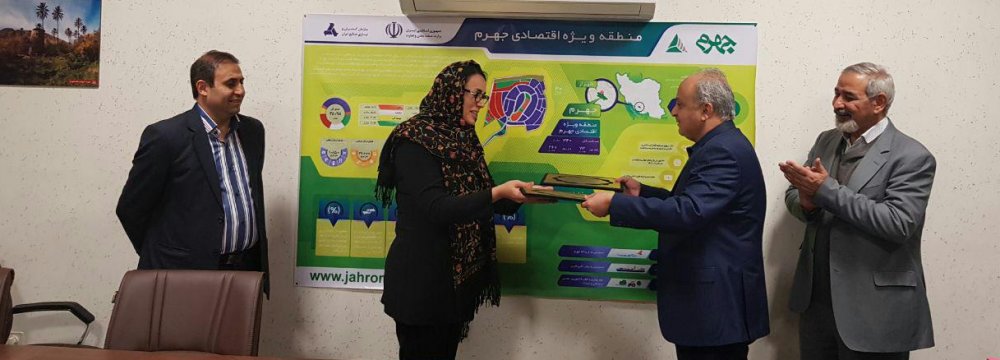
Bulgarian Company Plans Solar Investment in Iran

"The first investment agreement in Jahrom Special Economic Zone has been signed with Solar & Benefit Corporation to build a photovoltaic power plant," said Alireza Sahraeian, the governor of Jahrom, IRNA reported on Thursday. He did not specify the plant's capacity or the value of the investment.
According to a statement on Solar & Benefit's website, the Sofia-based company is to develop power projects in Iran with a total output capacity of 400 megawatts in collaboration with Grass Group, a German solar energy EPC contractor.
As per the agreement, Solar & Benefit will be compensated for 20 years at a price of 15.2 euro cents per kilowatt hour. The Bulgarian enterprise runs its operations through its local company Solar & Benefit Persia.
Iran's installed renewable power capacity of below 500 MW falls short of having a meaningful contribution to the national grid while new solar and wind ventures are regarded as more of a first step into a nascent renewable market.
But Sahraeian said the deal with Solar & Benefit is to meet a portion of electrical demand in Jahrom with a population of 230,000.
"The agreement is to provide part of the country's power needs and boost supply stability in the region through renewable energy resources," he said. Jahrom is approximately 200 kilometers off the Persian Gulf coast and 800 kilometers south of the capital Tehran.
Fars is a dry region with huge sunlight exposure, making it an attractive region for foreign investors. According to local officials, close to $2 billion was raised by February for renewable ventures in Fars.
Sahraeian also hoped that tax and customs incentives will help fire up investment in Jahrom Special Economic Zone which is under development in two phases as one of the five economic zones in Fars.
Renewable Initiative
The lifting of international sanctions in Jan. 2016 allowed Iran to open its energy market to outside investors, with foreign companies showing a strong appetite for renewable projects.
The government has commissioned the construction of $7.3 billion worth of renewable power plants through foreign investment in a drive to diversify the country's energy mix that is dominated by oil and gas.
Central to new potential investments are a $2.9-billion preliminary agreement with Norway's Saga Energy and a $600-million contract with London-based Quercus, with the latter committed to building one of the world's largest solar farms with a 600-MW capacity.
Iran holds some of the world's largest oil and gas riches and renewable energy sources have long lived under the shadow of fossil fuels that meet most of the country's energy needs.
The Energy Ministry says it hopes to launch 1,000 MW of renewable capacity a year through 2022 with the help of the private sector.


Trump weighs using $2 billion in CHIPS Act funding for critical minerals

Codelco cuts 2025 copper forecast after El Teniente mine collapse

Electra converts debt, launches $30M raise to jumpstart stalled cobalt refinery

Barrick’s Reko Diq in line for $410M ADB backing

Abcourt readies Sleeping Giant mill to pour first gold since 2014

Nevada army depot to serve as base for first US strategic minerals stockpile

SQM boosts lithium supply plans as prices flick higher

Viridis unveils 200Mt initial reserve for Brazil rare earth project

Tailings could meet much of US critical mineral demand – study

Kyrgyzstan kicks off underground gold mining at Kumtor

Kyrgyzstan kicks off underground gold mining at Kumtor

KoBold Metals granted lithium exploration rights in Congo

Freeport Indonesia to wrap up Gresik plant repairs by early September

Energy Fuels soars on Vulcan Elements partnership

Northern Dynasty sticks to proposal in battle to lift Pebble mine veto

Giustra-backed mining firm teams up with informal miners in Colombia

Critical Metals signs agreement to supply rare earth to US government-funded facility

China extends rare earth controls to imported material

Galan Lithium proceeds with $13M financing for Argentina project

Kyrgyzstan kicks off underground gold mining at Kumtor

Freeport Indonesia to wrap up Gresik plant repairs by early September

Energy Fuels soars on Vulcan Elements partnership

Northern Dynasty sticks to proposal in battle to lift Pebble mine veto

Giustra-backed mining firm teams up with informal miners in Colombia

Critical Metals signs agreement to supply rare earth to US government-funded facility

China extends rare earth controls to imported material

Galan Lithium proceeds with $13M financing for Argentina project

Silver price touches $39 as market weighs rate cut outlook

















